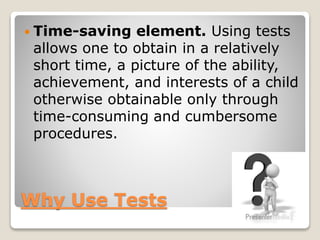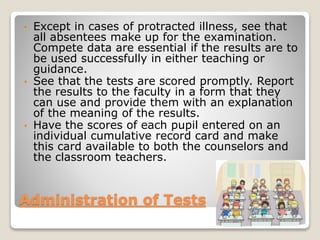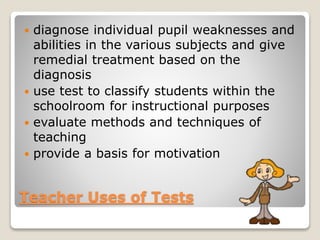Georpe testing in the guidance program
- 3. 1. A procedure for critical evaluation; a means of determining the presence, quality, or truth of something; a trial 2. A series of questions, problems, or physical responses designed to determine knowledge, intelligence, or ability. 3. A basis for evaluation or judgment Meaning of Testing
- 4. TESTING IN THE GUIDANCE PROGRAM Reported by: Sharlene Mae A. Georpe III – 26 BS Psychology – Guidance & Counseling Stream
- 5. The Place of Tests in the Guidance Program Planning a Testing Program ◦ Why Use Test ◦ The Administrator’s Role ◦ The Teacher’s Role Guiding Principles of Test Selection Administration of Tests Interpretation and Use of Tests in Counseling ◦ Counselor Uses of Tests ◦ Administrator Uses of Tests ◦ Teacher Uses of Tests A Basic Testing Program Criteria for Determining the Effectiveness of a Testing Program Different Kinds of Tests Overview
- 6. Impartial, objective nature. The large amount of available data that can be collected about the child for a case study is little more than parental or teachers’ opinion and needs verification by more objective information. Tests provide this necessary information. Why Use Tests
- 7. Time-saving element. Using tests allows one to obtain in a relatively short time, a picture of the ability, achievement, and interests of a child otherwise obtainable only through time-consuming and cumbersome procedures. Why Use Tests
- 8. Approximately same meaning results for all trained personnel. No counselor or teacher can be with a student throughout his entire life; therefore he must depend upon a clear and concise method for transmitting information about the student. Where words and opinions may have different meanings for different persons, a percentile rating or a standard score has universal meaning for those trained in their use. Why Use Tests
- 9. Provide clues permitting the counselor to gain facts not readily observable. The elements of a personality problem, for example, are usually subtle and concealed; often it is difficult for even a trained counselor to get a disturbed person to express himself honesty. An objective test, such as a personality inventory, will frequently give the counselor clues concerning the direction in which the trouble lies. Why Use Tests
- 10. Increases the probability of sampling all the traits of the individual. Through association and observation, many abilities may be noted, but a disability or talent entirely missed by other procedures is frequently uncovered by a test. Fortunately, the information gained from tests permits us to perceive the individual in terms of factual material that may guide us in assisting him to meet his problems. Why Use Tests
- 11. assure a clear recognition of needs to be served develop an understanding among all staff members of their respective roles and the contribution that each can make to the program PLANNING A TESTING PROGRAM
- 12. should be specifically responsible for selecting expertly-trained people who are qualified to choose, administer, score and interpret the tests responsible for developing a well-defined philosophy of education among his educational staff in which the purposes of standardized tests and the role that they play in meeting the needs of the student will clarified help determine the number of areas to be tested establish a schedule for giving the test provide the initiative and leadership in using the test results Administrator’s Role
- 13. acquainting the student in his classes with the testing procedures with the nature of the tests and with the value of tests evaluate critically the achievement tests to be administered, especially in his own subject matter field uses test results to individualize instruction and to assist the student in making desirable choices in life adjustments Teacher’s Role
- 14. According to Traxler: secure a statement of the school’s objectives have high validity and reliability determine the usability of test easily and objectively scored ease of interpretation and application of test consideration of the cost mechanical character of the test itself Guiding Principles of Test Selection
- 15. • • • Select the tests carefully, preferably in cooperation with a faculty committee Order the tests well in advance of the date on which they are to be used. Allow plenty of time to get all the material ready before the first day of the testing sessions. Plan in detail for the administration of the tests. Choose examiners and proctors with great care. Administration of Tests
- 16. • • • Ditto or otherwise duplicate an examination schedule and see that every person concerned receives a copy of it. Avoid overemphasis on the tests. Urge the teachers to have the pupils take them “in stride.” Give pupils, who have never taken an objective test, an opportunity to examine old tests of this kind. Administration of Tests
- 17. Do not distribute the tests to the examiners before the day of the examination. • Provide each examiner with a manual and a sample copy of the test several days before the examination and urge him to study the manual and to practice by taking the test himself. • Provide each examiner and proctor with a written set of instructions outlining his duties during the examination. • Administration of Tests
- 18. When administering tests by large groups: Make arrangements so that there will be no interruptions or distractions during the testing period. Persons should not enter or leave the room unless absolutely necessary. Seat pupils in alternate chairs, if possible. See that each proctor understands what is expected of him. Administration of Tests
- 19. Make announcements slowly and clearly in a voice that is loud enough to be heard throughout the room. Assume a businesslike and efficient attitude that will command attention, but do not be unnecessarily severe. Remember that some pupils become nervous when faced with an examination. Have proctors supply all pupils with test material and pencils. Announce that the pupils are not to write on the booklets nor to open them until so instructed. Administration of Tests
- 20. Have the blanks on the front of the booklets or answer sheets filled out, and in the code of certain kinds of answer sheets, follow the directions for coding them. Be sure to announce the date, how names are to be written, and other items that may need clarification. Spend sufficient time on this step to see that the information is given correctly by the pupils. Age and birth dates are especially important on tests of academic aptitude. Administration of Tests
- 21. Hold faithfully to the exact wording of the printed directions unless there is an excellent reason for introducing a minor variation in them. The preparation of directions for a test is one aspect of test construction and standardization. The wording of the directions has been carefully thought out by the test author. Don’t improvise or introduce short cuts. If you do; you may change the test results significantly. Administration of Tests
- 22. Time the examination with extreme care, using a watch which has a second hand and which has been checked for accuracy. It is advisable to have one of the proctors check your timing to be sure that no error occurs. In some tests, accurate timing is the most important single feature of the entire procedure of administering them. Administration of Tests
- 23. Move about the room occasionally to see that all pupils are working on the right part of the examination, but do not stand gazing over a pupil’s shoulder until he becomes self-conscious, and do not constantly move nervously from pupil to pupil. Stop the examination immediately when the time is up and collect the booklets. Administration of Tests
- 24. If the tests are administered with separate answer sheets for scoring with the older model of the IBM Test-Scoring Machine, make sure that all pupils have made their response marks heavy, black and glossy, and have erased stray marks before the answer sheets are turned in. One procedure is to allow a few moments for the darkening of the responses and the erasing of stray dots and other marks after the pupils have handed in their booklets but before the answer sheets are collected. If this procedure is followed, the pupils should be very carefully supervised to make sure that none of them mark at random items which they did not reach during the time limit for the administration of the test. Administration of Tests
- 25. As soon as a certain test has been given, have all examiners turn in their booklets promptly. Alphabetize and check the test papers against the class lists. • If tests are given with separate answer sheets and if the same booklets are used with successive groups, be sure to have them carefully inspected after each use. • Administration of Tests
- 26. Except in cases of protracted illness, see that all absentees make up for the examination. Compete data are essential if the results are to be used successfully in either teaching or guidance. • See that the tests are scored promptly. Report the results to the faculty in a form that they can use and provide them with an explanation of the meaning of the results. • Have the scores of each pupil entered on an individual cumulative record card and make this card available to both the counselors and the classroom teachers. • Administration of Tests
- 27. If the school has access to electronic computers, use this equipment to summarize test score evidence concerning individual pupils with respect to particular guidance questions. Although some guidance theorists questions whether testing is a legitimate guidance activity, surveys indicate that in the schools themselves “the testing program is the domination and expanding aspect of guidance.” Interpretation of test scores in relation to other data is often difficult, and it may be possible to achieve the goal of sounder interpretation by use of the computer and continuous, longitudinal studies. Administration of Tests
- 28. According to Willey and Andrew: when test scores are given to the student, they be expressed in percentiles or in such descriptive terms as above average or below average if the student is going to understand the meaning of his scores, they should be explained in a descriptive manner INTERPRETATION AND USE OF TESTS IN COUNSELING
- 29. if test scores are to be given to the student by means of a written report, careful explanation should accompany the report, clarifying the meanings of the factors being measured and where the pupil can receive individual interpretations of his tests such terms as I.Q.’s maladjustments, and so on, should be omitted in the process of explanation INTERPRETATION AND USE OF TESTS IN COUNSELING
- 30. Test results can benefit the counselee by indicating: how his pattern of interests compares with the pattern of interests of successful workers in given vocations whether his intellectual capacity will permit him to profit from further schooling his areas of special aptitude what he has achieved in school subjects and in learning skills whether there are any gross variations in his personality traits from those of his peers Counselor Uses of Tests
- 31. provide records of pupil achievement and progress strengthen reports to parents makes available more systematic and objective records when a pupil is transferred to another school provide data for periodic reports of school progress to the community Administrator Uses of Tests
- 32. discover the scholastic aptitude of the pupil and then adapt the instruction to the level of the aptitude determine the achievement level of the student so that he may begin his training at the best place for him discover the exceptionally bright and slow-learning pupils so that special provisions may be made for them Teacher Uses of Tests
- 33. diagnose individual pupil weaknesses and abilities in the various subjects and give remedial treatment based on the diagnosis use test to classify students within the schoolroom for instructional purposes evaluate methods and techniques of teaching provide a basis for motivation Teacher Uses of Tests
- 34. Grade Kindergarten First Second Third Third Fourth Fifth Sixth Seventh Eighth Ninth Ninth Ninth Tenth Eleventh Twelfth Time of Administration Type of Test End of year Beginning of year Reading readiness Mental abilities Beginning of year End of year Beginning of year Mental ability Test of achievement Prognostic reading End of year Test of achievement Beginning of year Beginning of year End of year Interest test Mental ability Test of achievement End of year End of year Interest test Achievement test A BASIC TESTING PROGRAM
- 35. Is the testing program comprehensive? It should indicate various kinds of tests and give a profile of the student’s strengths and weaknesses. Does the testing program include all the pupils in the school? Effort should be made so that all children are tested in order to gain a more comprehensive picture. Criteria for Determining the Effectiveness of a Testing Program
- 36. Are tests given at regular intervals? If tests intervals are regular, growth of the pupil will be easy to study. Are tests well-timed? They should be given during the year where they will be of maximum usefulness. They should be given at the beginning of the subject, before the semester is finished. Criteria for Determining the Effectiveness of a Testing Program
- 37. Are tests in the school testing program comparable? Do the tests agree with objectives and curriculum of the school? Are the specific tests carefully chosen? A competent group of people should study the test and all available statistical data. Criteria for Determining the Effectiveness of a Testing Program
- 38. Are the tests carefully administered to each pupil? If teachers are to give the tests, they should have instructions in proper administration. They should understand the purpose and value of tests and have a favorable attitude toward them. Are tests scored accurately? As a rule, a trained clerical staff can score a group of tests more accurately than a trained group of teachers. Criteria for Determining the Effectiveness of a Testing Program
- 39. Are test results interpreted in terms of appropriate norms? National norms are useful in the average school, but not for a remote rural area or a college preparatory group. Are test results reported quickly to teachers and counselors in understandable terms? Are the test results recorded upon individual cumulative record forms? Criteria for Determining the Effectiveness of a Testing Program
- 40. Is a definite effort made to relate the test scores to other kinds of information? Test scores alone do not give a complete picture of a person, they must be considered along with other available information. In addition to the regular testing program, is there special testing, as needed? Does the school have an in-service program for educating teachers in the use of test results? All teachers should have an understanding of test scores, class medians and percentile ranking so that they may interpret and use the results wisely in their fields. Criteria for Determining the Effectiveness of a Testing Program
- 41. A. Achievement General Reading Mathematics Science Language English Spelling Vocabulary Grammar History Social Studies Geography Handwriting Health Home Economics Aeronautics Commerce Library Information Psychology Engineering Journalism Automobile Driving Different Kinds of Tests(Woodruff)
- 42. B. Attitudes C. Aptitude (General Battery) Practical Judgment Scientific Mechanical Pen and paper Manual Clerical Sales Stenography and Typing Visual Tests Arts Music Nursing Supervisor Vocational Medicine Educational Law Religion Different Kinds of Tests(Woodruff)
- 43. D. Intelligence I. Personal Selection General Mental Ability College Primary Mental Ability General E. Interests J. Critical Thinking General K. Preschool Readiness Test Vocational L. Study Skills Academic M. Status Information F. Personality and Adjustment N. Concepts G. Values H. Rating Scales Different Kinds of Tests(Woodruff)
- 44. Aquino, Gaudencio V. and Alviar, Cornelia C., Principles of Guidance and Counseling: A Modern Approach Reference:













































